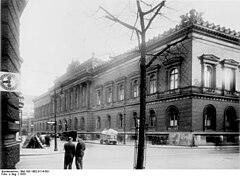Young Plan
Due to the effects of the Great Depression, the Young Plan was suspended by the Hoover Moratorium in June 1931 and payments reduced by 90% at the Lausanne Conference in July 1932.It reopened the American capital market to Germany, and billions in long-term bonds and short-term loans flowed to the German private and public sectors in roughly equal parts.The economy of the Weimar Republic grew significantly during the Golden Twenties (1924–1929), and in spite of a negative trade balance, there was enough foreign exchange to pay the instalments of the plan.[6] If the economy continued to develop positively, the plan's prosperity index would have required an even higher sum, which could have threatened to exceed Germany's ability to pay.Following extensive diplomatic consultations during the autumn meeting of the League of Nations, the six interested powers – Germany France, Great Britain, Belgium, Italy and Japan – agreed on 16 September 1928 to set up an international commission of experts under the leadership of American economist Owen D. Young to settle the reparations question and at the same time to begin negotiations on the evacuation of the occupied Rhineland.The foreign ministers of France and Germany, Aristide Briand and Gustav Stresemann, then called for a conference to be held to decide on the final settlement of all questions still arising from the First World War.[7] At the first session of the Hague Conference from 6 to 31 August 1929, the British chancellor of the Exchequer, Labour Party politician Philip Snowden, demanded an increase of annual reparations payments to Britain by the equivalent of 48 million Reichsmarks.Issues of a mostly technical nature were clarified, specifically the establishment of the Bank for International Settlements[9] to handle the transfer of reparations payments and the question of whether, as provided for in the Treaty of Versailles, creditors could continue to impose sanctions in the event of a German default.It was agreed that the creditor nations would regain their "full freedom of action" if the International Court of Justice found that Germany was in the process of "tearing up" the Young Plan.[10] The French saw in the statement the chance to fall back on the robust sanctions possibilities of the Versailles Treaty, while the Germans recognised in it merely the freedom of action to which every sovereign state was entitled under international law.The control that the creditor powers had secured in the Dawes Plan over the German National Railway and the Reichsbank were also dropped,[12] as was the prosperity index, which meant that Germany could be sure that it would not have to pay more if the economic situation was favourable.[17] The left-wing and liberal press judged it positively; only on the political right was criticism levelled that the plan and its accompanying withdrawal from the Rhineland affected both the financial and military security of the French Republic.Both the political right and the opposition Socialists, who otherwise supported Briand's foreign policy, insisted on linking the two debts, a position that the United States strongly opposed.He did not mention the original goal of mobilising reparations on a large scale and repaying the inter-allied debt as a lump sum because a financial operation of such a magnitude had become impossible after the New York Stock Exchange crash.With the seemingly permanent solution to the reparations question and the withdrawal from the occupied Rhineland, the last points of contention stemming from the Treaty of Versailles appeared to have been resolved and the way cleared for a secure and peaceful future.With the severe world-wide economic downturn that heralded the Great Depression, United States President Herbert Hoover won support for a one-year moratorium on reparations payments from 15 nations by July 1931.





Young Plan (Hong Kong)Paris Peace ConferenceLeague of NationsCovenant of the League of NationsMembersOrganisationMinority TreatiesLittle Treaty of VersaillesMandatesTreaty of Versailles"War Guilt" clauseReparationsDawes PlanHague conference on reparationsLausanne ConferenceLocarno TreatiesInternational Opium ConventionTreaty of Saint-Germain-en-LayeTreaty of Neuilly-sur-SeineTreaty of TrianonMillerand letterTreaty of SèvresPartition of the Ottoman EmpireConference of London (1920)San Remo conferenceTurkish National MovementTurkish War of IndependenceTreaty of LausanneAmerican Commission to Negotiate PeaceCommission of ResponsibilitiesThe InquiryWorld War I reparations obligationsOwen D. YoungThe Hague conferenceReichsmarksoccupied RhinelandGreat DepressionHoover MoratoriumNational SocialistAdolf HitlerInter-Allied Reparations Commissionoccupied the RuhrhyperinflationWeimar RepublicWall StreetCharles DawesMellon–Berenger AgreementChamber of DeputiesAristide BriandGustav StresemannFirst World WarHague ConferenceLabour PartyPhilip SnowdenBank for International Settlementsstock market crashReichsbankReparation CommissionGerman National RailwayRaymond PoincaréSocialistsAndré TardieuDemocratic Republican AllianceRepublican FederationReichstagPaul Reynaud1929 German referendumAlfred HugenbergGerman National People's PartyNazi Partywar guiltFreedom Law referendumWall Street Crash of October 1929Herbert HooverLausanne Conference of 1932World War IIAnglo-German Payments AgreementsterlingLondon Agreement on German External DebtsWest GermanyreunificationMöller, HorstNohlen, DieterParis Peace Conference (1919–1920)LocarnoStresa FrontPossible cause of the Second World WarBig FourList of participantsA Peace Conference at the Quai d'OrsayThe Signing of Peace in the Hall of MirrorsTo the Unknown British Soldier in France